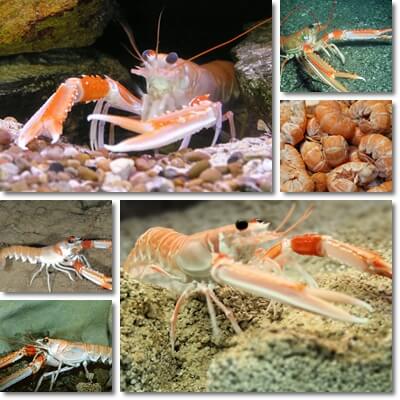It tastes like lobster, looks like shrimp and it’s called langoustine or scampi (scientific name: Nephrops norvegicus). Despite the confusion regarding its name, appearance and taste which all suggest different seafood species, langoustine is actually a small species of lobster, one that is quickly on its way to becoming the next best alternative to the reigning seafood delicacy that is lobster. Langoustine belongs to the genus Nephrops, one of three major divisions (genera) of lobsters with claws – the other two being Homarinus and Homarus which includes the common lobster and the American lobster.
What exactly is langoustine?
Langoustine is a species of small lobster (scientifically known as Nephrops norvegicus). It also goes by the name of langoustine lobster, an association of words that is meant to clarify what the species is to those unacquainted with it (a type of lobster, but not the American or Maine lobster). Other common names include Norway lobster and Dublin Bay prawn and hint at the crustacean’s natural habitat, the NE Atlantic Ocean and North Sea, with reference to the Northern and Central European countries bordered by these two bodies of water.

Langoustine is also commonly called scampi. This particular choice of a name can be traced back to the culinary preparation style with the same name. “Scampi” involves lightly frying smaller crustaceans such as shrimp, prawn or small lobsters in garlic butter or oil. Depending on the recipe, the crustaceans may then be eaten plain, served with pasta, rice or fried in breadcrumbs. Because langoustine looks a lot like shrimp or prawn and is even cooked in the scampi style, just like shrimp and prawn, it is sometimes referred to simply as ‘scampi’.
What does langoustine look like?
Not quite like a lobster, although it’s one. Langoustine looks more like a larger species of shrimp or prawn. Compared to the American (or Maine) lobster which can grow to lengths of 60 cm and weigh 20 kilograms, it only reaches a maximum of 20-25 cm in length, tail included, and 250 grams. It’s also narrower in shape. The rather lobsteresque front claws and tail are the only things giving it away that it’s a lobster and not a shrimp or prawn. The front pair of legs consists of claws, one ‘crusher’ and one ‘cutter’ and they are both lined with sharp, spiny-like structures. The next two pairs of legs also have claws, but these are underdeveloped compared to the main claws. The tail is fan-shaped at the end. The eyes are beady-like, kidney-shaped and black and there are two pairs of antennae of different lengths. The langoustine is orange-pink on top and white underneath.
What does langoustine taste like?
It tastes like lobster which is unsurprising given it is a species of lobster. The tail is the primary source of meat, but the meat from other parts such as the claws or head, although slightly less accessible, may also be consumed. Langoustine taste is delicate, faintly sweet and the meat has a pleasant, soft texture. The raw, uncooked tail meat is typically translucent white, but loses it translucence when cooked. There may be a tinge of orange-red to it from the carapace, depending on the choice of cooking method. The carapace doesn’t change color as a result of cooking, but may become slightly paler or lighter. It is assumed most people cannot accurately distinguish between true, American lobster meat and langoustine meat given they taste so similar. Langoustines are available fresh, frozen, pre-cooked and frozen, in shell and shelled.

Nutrition and health benefits
Langoustine nutrition is similar to that of other seafood such as shrimp, prawn, crab and lobster. Langoustine is an important dietary source of Omega-3 fatty acids, cholesterol and protein, but overall low in saturated fat and calories. It is typically high in B vitamins, especially vitamin B12 and B3 and a good source of iodine, selenium and copper. It provides good amounts of calcium, magnesium, iron, potassium and zinc and is especially high in phosphorus and sodium. Lastly, the crustacean is known to be low in mercury and other heavy metal contaminants, one of the properties that contribute to its beneficial health effects.
Below is a list of potential benefits associated with langoustine consumption:
1) Low in calories and carbohydrates and high in protein, it supports healthy weight loss.
2) Generous amounts of protein for building muscle.
3) Support for memory and learning from healthy Omega-3 fatty acids.
4) Brain food. Omega-3 fatty acids in the form of EPA and DHA contribute to brain integrity, meaning they actually become part of our brain cell membranes and tail of nerve cells.
5) Omega-3 fatty acids may promote lower risks of depression and anxiety and help prevent early cognitive decline.
6) More benefits for brain and nervous system health from vitamin B12 and cholesterol which maintain the integrity of the myelin coating surrounding the tail of nerve cells (loss of myelin coating occurs with neurodegenerative diseases of the nervous system such as multiple sclerosis).
7) Cholesterol helps synthesize hormones for better fertility and vitamin D for both better female fertility and a stronger immune system.
8) Despite being high in cholesterol, langoustine is low in overall fat and saturated fatty acids and doesn’t raise blood cholesterol or triglyceride levels.
9) Omega-3 fatty acids help improve HLD-LDL ratio, raising HDL cholesterol levels (the good kind).
10) Anti-inflammatory benefits and benefits for skin from Omega-3.
11) Benefits for thyroid health from iodine and selenium. Good thyroid function means optimal fertility and metabolism.
12) Strong bones and teeth from phosphorus, calcium and magnesium.
13) More energy from B vitamins and increased vitality from vitamin B12 and iron in particular.
14) Anti-anemia food. Vitamin B12 and iron combat tiredness, fatigue, muscle weakness and other symptoms of anemia.
15) Benefits for the immune system from zinc, copper and overall good nutritional profile.
Side effects and contraindications
As with other seafood, potential side effects of langoustine consumption include risk of allergic reactions in those allergic to lobster or crustaceans in general, bacterial or parasitic infections from the undercooked meat and rise in blood pressure numbers from the high sodium content. There may also be pregnancy contraindications.
1) Allergic reactions. If you know or suspect your are allergic to seafood, whether to lobster or langoustine or another crustacean, the only solution is complete avoidance of the allergen, in all forms and preparations.
2) Food-borne illness. Cooking langoustine thoroughly, preferably through boiling, completely destroys bacteria and parasites. Anyone with immune system deficiencies, pregnant women, children and the elderly, categories most at risk for complications, should avoid raw or undercooked seafood and meat in general.
3) Pregnancy contraindications. Pregnant women with high blood pressure should avoid eating langoustine too often because the crustacean is naturally high in sodium (not to mention that it’s usually cooked in salted water and seasoned with salt). While low in contaminants such as mercury, it is best consumed occasionally, similar to other seafood to avoid heavy metal contamination. Occasional consumption may benefit both the mother and baby thanks to high amounts of vitamin B12 and good amounts of iron which restore vitality and combats anemia as well as important amounts of EPA and DHA Omega-3 fatty acids which help with brain and nervous system development of the baby.
4) Cardiovascular contraindications. The high cholesterol content of some seafood is usually seen as a contraindication in cardiovascular disease management. However, dietary cholesterol does not raise blood cholesterol, according to recent research. Instead, dietary fat, especially saturated fat has the most harmful effect on the cardiovascular system and raises blood cholesterol levels. Since langoustine is low in fat, it does not pose risks for those who need to manage their fat intake and lower their cholesterol levels. But because it is naturally high in sodium, it’s best eaten infrequently if you have high blood pressure.
How to choose langoustine
If possible, always choose fresh langoustines – the flavor should be wonderful. Look for shiny eyes and a fresh smell, reminiscent of the sea (similar to what you would look for in fish). Avoid those smelling fishy or with bruised, broken shells, legs or antennae. If you are looking to get shelled langoustines, know that the meat should be a translucent white and smell fresh, not fishy. Frozen options should keep very well and maintain a pleasant flavor. Fresh crustaceans can kept for up to 24 hours in the refrigerator.
How to cook langoustine
As a gastronomic delicacy rivaling the American lobster, langoustine is best cooked in a manner that brings out its delicate, sweet flavor so simple recipes are preferred. The simplest way to cook it is to bring a pot of salted water to boil, then boil the crustacean for up to 10 minutes. Make sure the pot is not crowded and, if needed, cook a few of the crustaceans at a time. Serve with lemon slices, a butter and garlic sauce, mayonnaise or over pasta or rice (paella).
Another great way to cook langoustines is to lightly fry them in a garlic sauce. Heat butter or oil in a pan, saute some garlic then add the langoustines (whole or tails). Remember to turn them onto the other side every few minutes until thoroughly cooked. Season with salt or favorite spices or herbs such as fresh parsley or serve with lemon or lime slices. It should take up to 10 minutes for a whole, medium langoustine to cook. If you are using shelled tails, 4-5 minutes should ensure thorough cooking of the meat, although cooking time differs according to size of the crustaceans. For cooking on the grill: split the langoustine halfway, remove the vein (stomach and intestines) and potential grit, rinse with cold water, season according to your liking then grill.
